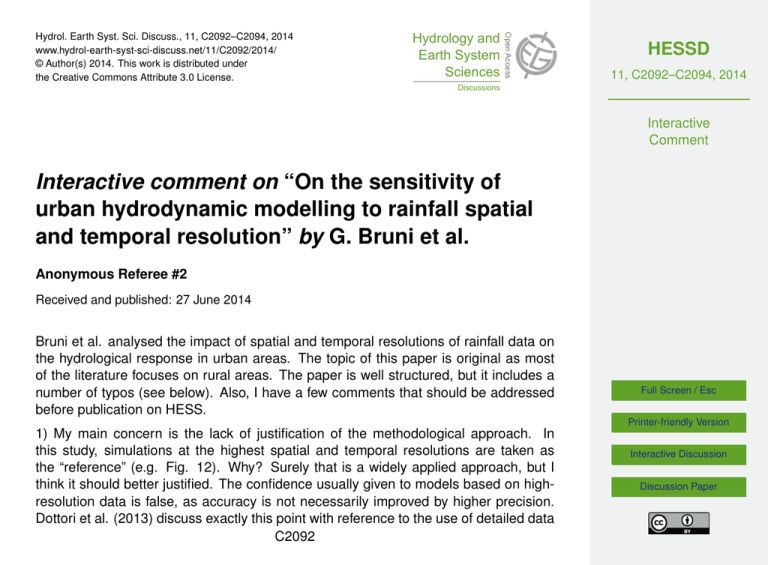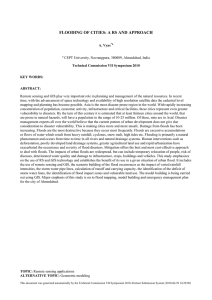Interactive comment on “On the sensitivity of urban hydrodynamic
advertisement

Hydrology and Earth System Sciences Open Access Hydrol. Earth Syst. Sci. Discuss., 11, C2092–C2094, 2014 www.hydrol-earth-syst-sci-discuss.net/11/C2092/2014/ © Author(s) 2014. This work is distributed under the Creative Commons Attribute 3.0 License. HESSD 11, C2092–C2094, 2014 Discussions Interactive Comment Interactive comment on “On the sensitivity of urban hydrodynamic modelling to rainfall spatial and temporal resolution” by G. Bruni et al. Anonymous Referee #2 Received and published: 27 June 2014 Bruni et al. analysed the impact of spatial and temporal resolutions of rainfall data on the hydrological response in urban areas. The topic of this paper is original as most of the literature focuses on rural areas. The paper is well structured, but it includes a number of typos (see below). Also, I have a few comments that should be addressed before publication on HESS. Full Screen / Esc Printer-friendly Version 1) My main concern is the lack of justification of the methodological approach. In this study, simulations at the highest spatial and temporal resolutions are taken as the “reference” (e.g. Fig. 12). Why? Surely that is a widely applied approach, but I think it should better justified. The confidence usually given to models based on highresolution data is false, as accuracy is not necessarily improved by higher precision. Dottori et al. (2013) discuss exactly this point with reference to the use of detailed data C2092 Interactive Discussion Discussion Paper in urban flood modelling (very similar to this paper) and provide many concrete examples of why we should prefer to be approximately right, rather then precisely wrong. 2) My second concern is about the first sentence of the paper, which states: “Cities are increasingly vulnerable to floods generated by intense rainfall, because of. . . and changes in precipitation patterns due to climate change”. First, this statement is not correct from a terminological viewpoint, as precipitation patterns affect flood hazard, not the vulnerability to floods. Second, I could not find any references to peer-review papers that urban floods are increasing because of changes in precipitation patterns due to climate change. Actually, while many media often use this argument to capture attention, I have some doubts about the presence of scientific articles demonstrating that changes in patterns of extreme precipitation have led to increasing floods in urban areas (things are rather more complex, see e.g. various papers of Villarini and others...). Even the IPCC 2012 Report states: "the AR4 and the IPCC Technical Paper VI based on the AR4 concluded that no gauge-based evidence had been found for a climate-driven globally widespread change in the magnitude/frequency of floods during the last decades (Rosenzweig et al., 2007; Bates et al., 2008)". IPCC (2012) also review all the flood trend studies made around the world and concludes that "widespread evidence of such climate-driven changes in floods is not available. For example, there is no evidence of widespread common trends in the magnitude of floods based on the daily river discharge of 139 Russian gauge stations for the last few to several decades, though a significant shift in spring discharge to earlier dates has been found (Shiklomanov et al., 2007). Lindström and Bergström (2004) noted that it is difficult to conclude that flood levels are increasing from an analysis of runoff trends in Sweden for 1807 to 2002 [...] Di Baldassarre et al. (2010) found no evidence that the magnitude of African floods has increased during the 20th century." Things are much clearer when one looks at the vulnerability of human societies. Here, the increasing trend is widely demonstrated by the literature. The same IPCC (2012) recognises this: " Globally, the pressure for urban areas to expand onto flood plains and coastal strips has resulted in an increase in exposure of populations to riverine and coastal flood risk (McGranahan C2093 HESSD 11, C2092–C2094, 2014 Interactive Comment Full Screen / Esc Printer-friendly Version Interactive Discussion Discussion Paper et al., 2007; Nicholls et al., 2011). For example, intensive and unplanned human settlements in flood-prone areas appear to have played a major role in increasing flood risk in Africa over the last few decades (Di Baldassarre et al., 2010)." Hence, I would rather say that: cities are increasingly vulnerable to floods because of rapid urbanization of flood prone areas, etc. . . 3) In the conclusions, the authors discuss future perspectives and state: “more storm events should be analysed to confirm the findings of this study. Such an extension of the study would allow giving reliable recommendations on what should be the model and rainfall resolution in order to prioritise either the improvement on rainfall estimation or catchment hydrological characterization.” I don’t fully disagree on this point, but I think that it is not sufficient. Not only more storm events are needed, but also realworld observations of hydrological conditions to validate the results of models based on different resolution are needed. This would allow studying how both the accuracy and precision of hydrological response are affected by the temporal and spatial resolution of rainfall data. HESSD 11, C2092–C2094, 2014 Interactive Comment 4) There are a few typos in the paper (“form 10 to”, “Analysed are based”, etc. . .) Please, double-check the English! REFERENCES Dottori, F., G. Di Baldassarre, and E. Todini (2013). Detailed data is welcome, but with a pinch of salt: Accuracy, precision, and uncertainty in flood inundation modeling, Water Resour. Res., 49, 6079–6085, doi:10.1002/wrcr.20406. IPCC (2012). Managing the Risks of Extreme Events and Disasters to Advance Climate Change Adaptation. Cambridge University Press, Cambridge, UK, and New York, NY, USA, 582 pages. Interactive comment on Hydrol. Earth Syst. Sci. Discuss., 11, 5991, 2014. C2094 Full Screen / Esc Printer-friendly Version Interactive Discussion Discussion Paper






![My Flood Project [WORD 624KB]](http://s3.studylib.net/store/data/007180649_1-37937117fa0d9f223031a6f75d9a4179-300x300.png)